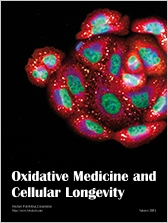
Authors: Ewin B. Almeida, Juliana M. B. Santos, Vitória Paixão, Jonatas B. Amaral, Roberta Foster, Adriane Sperandio, Tamaris Roseira, Marcelo Rossi, Telma G. Cordeiro, Fernanda R. Monteiro, Gislene R. Amirato, Carlos A. F. Santos, Rodolfo P. Vieira, Mauro Vaisberg, Marcelo P. Barros, André L. L. Bachi.
Abstract
Although regular combined aerobic-resistance exercises can ameliorate the inflammatory status and redox balance in elderly population, it is unclear whether protein or specific amino acid supplementation could improve such benefits. Therefore, we aimed to evaluate the inflammatory status and redox indexes through of the saliva of 34 elderly subject nonpractitioners (NP group, years) and 49 elderly subject practitioners of a combined-exercise training in moderate intensity (CET group, years) before (pre) and after (post) 30 days of supplementation with L-glutamine (Gln) or placebo (PL). Our results showed that, both in pre- and postsupplementation, the salivary levels of nitric oxide (NO⋅) and TNF-α were lower, whereas the levels of uric acid and IL-10 (as well as IL-10/TNF-α ratio) were higher in the CET groups than in the NP groups. In postsupplementation, both groups supplemented with Gln (NP-Gln and CET-Gln) showed higher salivary uric acid levels compared to baseline. In addition, lower NO⋅ levels were found in the CET-Gln group postsupplementation than presupplementation values. Whereas the CET-Gln group showed lower GSH levels postsupplementation, NP-Gln subjects showed lower GSSG levels at the same time point, both compared to baseline. Interestingly, salivary peroxidase activity was lower only in NP groups (NP-PL and NP-Gln) postsupplementation than baseline values. A positive significant correlation between salivary peroxidase activity and GSH levels, and also between salivary peroxidase activity and uric acid levels were observed in the CET-Gln group both pre- and postsupplementation. No differences were found in albumin, total antioxidant activity (TEAC), and reducing power analysis between groups, pre- or postsupplementation. In conclusion, the elderly subjects from the CET group showed a better inflammatory response and redox balance and, for the first time, it was shown that daily supplementation with Gln for 30 days can improve these benefits with putative association with a healthy aging.
DOI: https://doi.org/10.1155/2020/2852181


